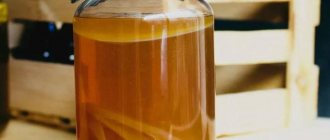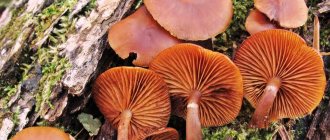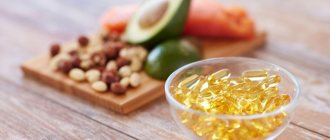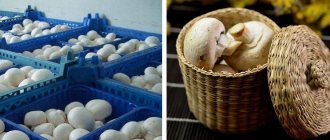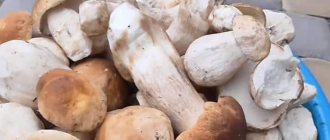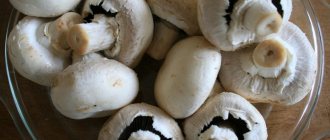Sank to the bottom
If the kombucha suddenly sinks to the bottom, stands upright and no longer rises to the surface, this indicates that some processes during its cultivation were disrupted. There may be several reasons why the kombucha sank to the bottom of the jar:
- The most common is temperature violation. If a tea jellyfish drowns and does not float up, this often means that the container in which it is located is located in a too cool room. The optimal temperature for growing mushrooms is 23-35 degrees. If the jar is placed, for example, in the refrigerator, then the infusion will not have enough heat for the normal fermentation process. Tea kvass can be stored in the refrigerator, but it is meant that it will be a drink drained from the main jar.
- Another reason why kombucha does not float in a jar lies in improper rinsing of the plate. It is known that tea jellyfish need to be periodically cleaned under clean running water. The liquid should be at room temperature. If you rinse with too hot water, the mushroom will be “stressed” and will lie at the bottom of the jar until it recovers.
- It happens that young kombucha does not float. This is normal, he just needs time to adapt after the separation.
- Also, medusomycete (this is the scientific name) can change its position due to lack of nutrition. If there is little sugar in the infusion (it should be about 80-100 g per 1 liter of tea), then a sufficient amount of carbon dioxide will not be produced. As a result, the gas bubbles that lift the tea jellyfish to the surface will not be enough, and we will see the mushroom fall to the bottom of the jar.
What's special about the composition?
The healing properties of kombucha are determined by the components that are released by a colony of microorganisms during their life activity (fermentation). Yeast fungi process sugar to form ethyl alcohol and carbon dioxide. Some of the alcohol is converted by bacteria into acetic acid. The drink also contains other acids that have therapeutic and prophylactic properties:
- Acetic: solvent, preservative;
- Glucuronic: antioxidant;
- Dairy: improves blood circulation;
- Caprylic: normalization of the gastrointestinal tract;
- Lemon: antidepressant.
As a result of fermentation, a pleasant-tasting liquid is obtained containing elements important for human life: organic acids, amino acids, catechins, polysaccharides; useful antibiotic medusin. Many enzymes are formed: amylase, lipase, catalase, protease.
| Squirrels | Fats | Carbohydrates | Calorie content 100 g |
| 5.24 g | 0 g | 9.98 g | 40 kcal |
The infusion contains aromatic oils, as well as bacteria with antiseptic properties. The drink contains vitamins B, PP and C, trace elements calcium, iron, iodine, zinc, copper, and caffeine from tea is retained.
Lying on its side
Now let’s figure out why the kombucha stands upright in the jar. There may also be several reasons for this:
- The mushroom is in an inappropriate, too small or narrow jar. In this case, he simply cannot straighten out normally on the surface and he has to “huddle” sideways in a cramped house.
- Another common reason why kombucha becomes ribbed is because there is too much liquid in the jar. Even using a 3-liter container, the infusion in it should be no more than ⅔ of the total volume. If tea is poured almost to the neck of the jar, the mushroom, trying to fit on the surface of the liquid, will take a vertical position.
- Sometimes a young jellyfish takes such an intermediate position. First, the plate lies at the bottom of the jar, then goes “on the edge,” and then rises to the surface, having undergone complete adaptation in the new tea solution.
- Also, the fungus can change position during reproduction: the adult layers are installed vertically, and in the meantime, a thin young film is formed on top.
Beneficial features
The rich composition of kvass from medusomycetes provides a huge range of beneficial properties for the human body, which it exhibits when consumed internally and externally.
For the digestive system
The tea drink stimulates the production of digestive juices, which promotes digestion. The enzymes contained in it reduce the load on the digestive glands (salivary, gastric, pancreas, liver).
The vitamin composition of tea kvass suppresses the proliferation of pathogenic intestinal microorganisms and maintains normal intestinal microflora. Thanks to the high concentration of B vitamins, Japanese mushroom kvass improves the body's immunity and resistance.
Regular consumption of this infusion in food reduces inflammatory reactions in the digestive tract. Fiber and other polysaccharides of the drink prevent the absorption of cholesterol from the intestines, absorb and remove toxic substances and waste from the body, prevent bloating and normalize stool.
For the condition of the heart and blood vessels
Tea kvass, when taken orally regularly as a remedy, normalizes heart rhythm, reduces heart rate, lowers blood pressure, tones the walls of venous vessels and has an anti-inflammatory effect.
Its components help reduce the concentration of cholesterol in the blood. Due to its anticoagulant effect, the drink improves microcirculation in tissues.
For the general condition of the body
The tea drink normalizes metabolism in the body, which has a beneficial effect on the general condition of a person, increases his vitality and improves his mood. Drinking the drink warm at night has a calming and hypnotic effect.
By promoting hematopoietic functions, kvass from medusomycetes increases the amount of hemoglobin in the blood and immunity. Taking the tea drink internally has powerful antioxidant and detoxifying effects on the human body. Literary sources contain information about the anticancer properties of this kvass.
External products based on this drink improve the condition of the skin and its appendages (hair, nails), relieve inflammation, and reduce allergic dermatological reactions.
Dark spots appear
In addition to the fact that the medusomycete may change its position in the jar, other problems may arise with it, for example, dark spots may appear on the surface. What are they and how to eliminate them?
If the spots are blue-green in color, it is most likely mold (we discussed how to prevent its appearance and what to do with such a fungus in a separate article). If the spots are dark brown, these are burns. The mushroom can get burned if sugar gets directly onto its surface.
If there are few dark burn spots, just do not touch the mushroom for several days, it will recover on its own. If most of the plate is damaged, in this case you can carefully remove 1-2 top layers and get rid of them. The remaining portion will continue to grow, turning ordinary tea into a healthy and tasty drink.
When kombucha changes its position in the jar, this usually does not mean some serious disease of the medusomycete; most likely, the technological processes of its breeding are simply disrupted. Once they are eliminated, after a few days, the tea jellyfish will return to normal on its own.
But if foreign “inhabitants” (midges, worms) appear around the mushroom, then this is already a signal to take completely different actions for treatment. Read more about this here.
Are there any contraindications for use?
There is no information about negative effects on the body. When properly prepared and taken, kombucha cannot harm the body of a healthy person. But patients with certain types of diseases should not drink the drink:
- diabetes mellitus type I;
- ulcers, inflammatory diseases of the gastrointestinal tract;
- high acidity;
- gout, etc.
It is not recommended to use tea kvass for people who have acute forms of any disease or are undergoing drug therapy. Drivers should drink the infusion with caution, because it contains a small percentage of alcohol (about 2%). For the same reason, pregnant and nursing mothers should not drink large amounts of the drink, although 1-2 glasses a day will only bring benefits. Due to the alcohol and caffeine content, the infusion is not given to babies under 6-12 months. From 3-4 years old, you can gradually increase the daily portion to the adult norm. Regular consumption of kombucha kvass can improve the well-being of both adults and children, saturating the body with additional energy from natural ingredients.
Kombucha turned upside down
I do this: for a three-liter jar, pour 3 tea leaves (in your case 2 or 3 teaspoons of tea leaves) into a mug with boiling water + 3 tablespoons of sugar. I stir well, remove the bags (through a strainer) and into a jar. Of course, there shouldn’t be a mushroom in the jar. I wash it with cool water and it sits on my plate and waits. Then I fill these bags again + another 3-4 tablespoons of sugar (we love sweet mushroom). In total, it takes me 6-7 tablespoons of sugar for two half-full mugs of hot water with tea bags. Then I add cold water to the jar up to the shoulders of the jar. The water should be slightly cool. If it's too warm, I wait for it to cool down. And then I carefully release the mushroom from my hand. It should lie on top of the liquid. It happens that he gets mischievous, sometimes he stands on his side, sometimes he turns over. It’s okay - he’ll either come to his senses on his own or you’ll turn him over with your hand. The main thing is that there should be no tea leaves and no sugar should get on the mushroom. And if the water in the jar is on top of the mushroom, then after 5-6 days you will have a young mushroom appear on top of the water. I usually wait 5 days, I'll try. There it is immediately clear that a fortress appears. That’s how it seems, if there’s anything, ask.
Thanks for the answer
I have another question - the mushroom is drowning, why? He's missing, right? At first it was on top, lying flat, but by morning it went to the bottom, maybe it was lying in the water for too long? And where should he stand? In the shadow? In the sun? On the table? In a refrigerator? Should the tea be strong? I got a dark one, I remember my aunt had one when I was a child - she seemed to have a light one and it was thick, but I only have one plate so far. Another question - does it have a top and a bottom? Well, I mean, is it important to lay it down, for example, with one side up? Or is it the same on both sides?
I’ve never had a mushroom in water, so I don’t even know what to say. Usually, when the tea leaves in a mushroom, it remains in the remaining liquid, but I never put it in water. If he was in the water for a short time, then it’s okay, when he was transferred to other owners, he was in the water for about a day, but no more. It’s on my kitchen table; it doesn’t need to be placed in the sun or in the cold. We do not pour the finished mushroom into another container, but gradually drink it through cheesecloth. Some people immediately pour it into another container and into the refrigerator, but without the mushroom, but with a new one. The strength of the infusion was written above, who does it differently, who gets it light. It’s also not worth it to be too black; it makes the mushroom darker. It becomes thick over time, a young mushroom grows on top, and there may be several layers of old underneath. With you, he is apparently still young, everything is ahead of him. Of course, the mushroom has a top, it is denser, the bottom is looser or something. Something like this, you can see it right away. There are also some type of mushroom hairs on the bottom. That seems to be it, if there is anything, just ask.
Harmful properties
The active substances contained in this drink in large quantities can also exhibit harmful properties in some diseases and conditions.
In order not to aggravate the patient’s condition, the use of tea kvass is contraindicated in case of inflammatory diseases of internal organs in the acute phase.
Possessing high acidity, the medusomycete infusion is contraindicated for use in gastritis with high acidity, gastric and duodenal ulcers in the acute stage.
The drink is contraindicated for gout and urolithiasis because it contains oxalic acid and purine bases.
You should not drink an infusion of Japanese mushroom before work that requires quick reaction and concentration, for example, driving a car, operating conveyors and conveyors.
The sugary compounds included in the drink increase the concentration of glucose in the blood, so its use is not recommended for diabetics.
The active compounds of kvass can interact with the active ingredients of various medications, so its use is prohibited simultaneously with painkillers, antipyretics, sedatives, hypnotics, tranquilizers, antacids, anticoagulants and antiplatelet agents.
Contraindications to the use of this drink are reduced blood clotting (clotting factor deficiencies, thrombocytopenia, pancytopenia).
The acids in the tea drink are easily oxidized and can react with the dishes in which it is infused, so the Japanese mushroom cannot be grown in ceramic, metal or clay dishes.
Tea kvass, due to the content of alcohols and aldehydes, is contraindicated in childhood, pregnancy and breastfeeding.
Drinking the drink is prohibited if you have individual intolerances or allergies.
What to do when your kombucha gets sick?
Ending, beginning about kombucha here:
Brown spots on the surface of the mushroom are burns from granulated sugar. Don’t rush to throw away such a mushroom; first try to cure it. To do this, you just need to stop pouring sugar on your pet’s wounds. He will do the rest himself, as long as there are only a few brown spots. If the burns are large, it is better to remove the top layer: the fungus cannot breathe in the affected areas of its body, and oxygen is vital for it.
But in principle, the more layers a mushroom has, the stronger and healthier it is. But such a mushroom is more difficult to manage - it is not easy to remove it from the jar and rinse it properly. So, if your mushroom has become so thick that it becomes difficult to remove, it is better to remove one or two layers.
You need to separate the fresh ones, that is, the top layers. The beard, on the contrary, should be groomed and cherished, because these are colonies of acetic acid bacteria that synthesize organic acids - the basis of the healing potential of kombucha. Only those beard fibers that have floated freely are removed.
What to do if the mushroom does not float to the surface of the tea solution? This happens with a young mushroom or when several layers are separated from a mature mushroom and it becomes too thin. Wait a few hours - maybe it will pop up. If not, reduce the amount of tea solution. Even if there is very little of it, it doesn’t matter: after one or two dressings, the mushroom will gain strength and will soon be able to feed the whole family.
Tea mushroom.
Kombucha can be drunk by everyone; no contraindications for its use have been found. (The only exception is for diabetes mellitus due to the presence of sugar in the infusion.) Constant use of kombucha infusion increases the body's protective functions.
Kombucha is useful for some forms of sore throat, conjunctivitis, pustular skin lesions and as a bactericidal agent. A three- to seven-day infusion of kombucha is taken half a glass an hour before meals 3-4 times a day. For gastrointestinal diseases, it is recommended to lie on your right side for an hour after taking kombucha. For various sore throats and tonsillitis, gargling is recommended. In case of a burn, put a thin layer of mushroom mass on the sore spot and change it as it dries until the redness goes away. The burn heals without a trace. For a runny nose, you can use gauze swabs soaked in a solution of kombucha. A greater effect is achieved if the tampons are renewed every half hour. Kombucha is very useful for children, it can be recommended instead of carbonated water, kvass, Coca-Cola, forfeits, etc. Caring for kombucha is not difficult, you just need to follow some rules: A two-three-liter jar with a wide neck, which must be closed, is suitable for it several layers of gauze. Do not cover the neck with a lid under any circumstances, as the fungus needs air for its life.
For the growth and development of the fungus, a solution of tea with sugar is needed. For a 3-liter jar, 5 tablespoons of sugar + a glass of tea leaves. The water for the solution is slightly heated, sugar is dissolved in it and then, once cooled, the sugar is added to the jar. You cannot pour sugar directly into the jar onto the mushroom, as you can burn the mucous membrane of the mushroom, as a result of which it will die.
It is better to have two jars: in one the mushroom will live, and in the other you will pour the finished drink. A jar of the finished drink can be stored in the refrigerator for quite a long time. The optimal temperature for the mushroom is 25 degrees. Direct sunlight is harmful to it, so it is better to keep it in the shade. Temperatures below 17 degrees are also harmful, as it reduces the activity of the fungus and blue-green algae can develop in it.
The mushroom infusion should be drained every 5-6 days in winter and every 2-4 days in summer. Also, do not forget that the mushroom must be washed regularly with clean, cool water; in summer this should be done every 1-2 weeks, and in winter every 3-4 weeks. If the mushroom remains in the solution, the upper film begins to turn brown. This is a sure sign that the mushroom is beginning to die. If this living organism is not fed in a timely manner or if its nutrition is completely stopped, the liquid turns into acetic acid, holes appear on the body of the kombucha, it painfully turns over, lies sideways for a long time, and then dies completely, slowly sinking to the bottom.
Today it is already known for sure that the infusion of kombucha helps to cure diseases such as: • Diseases of the gastrointestinal tract; • Diseases of the liver and gall bladder; • Diseases of the ear, nose and throat; • Chronic enterocolitis; • Infected wounds; • Hypotension; • Tonsillitis; • Sore throat; • Eye infections; • Acute dysentery; • Scarlet fever; • Diphtheria; • Typhoid fever; • Flu; • 0РЗ; • Gastritis; • Conjunctivitis; • Haemorrhoids.
Kombucha infusion strengthens and balances the action of the central nervous system, slows down and facilitates the course of tuberculosis. Very effective in combating constipation. Lowers blood pressure in patients with hypertension. In addition, the mushroom infusion actively restores the natural microflora of the stomach after illness and taking large doses of antibiotics and other medical chemicals. Kombucha infusion has antibacterial properties and compares favorably with most antibiotics in that it has a wide spectrum of action, which is not lost when stored at room temperature or when boiled.
How to care
There are several basic rules for keeping and caring for medusomycetes:
- The only correct container for keeping it is a glass jar. Usually this is a classic 3-liter or 5-liter container.
- It is advisable to keep the jar with your pet in a dark place. Do not leave the container in a draft or windowsill; direct sunlight and cold will destroy the product.
- The optimal air temperature should be around 25ºС; below 17ºС is harmful to the body. An incorrectly chosen temperature regime can cause the development of blue-green algae on the surface of the substance.
- It is best to cover the container with clean gauze or a cotton towel. Lids and cellophane cannot be used for this purpose.
- The nutrient substrate should be prepared from boiled water with tea and sugar already dissolved in it. You cannot sprinkle sugar on the body of the mushroom, as this causes severe burns and death. The same can be said about seagulls, which form ragged “wounds”.
- It is necessary to wash the jellyfish regularly. It is better to do this in spring or settled water, but if this is not available, you can wash it under the tap.
- Do not use hot nutrient substrate. Place your hand in the liquid; it should be slightly warmer than the air temperature.
- If you notice that a dark film has appeared on the surface of the mycete, this indicates a violation of the maintenance rules. Most often this happens when the mushroom is in the same solution for a long time, or you neglected to “bathe” it regularly.
Please note that in summer the fungal body works much faster than in winter, and the nutrient mixture needs to be changed much more often. To propagate the mushroom, you need to pour the drink into a separate jar and place the container for two weeks in a warm place, protected from sunlight. As a result, a mucous film can be seen on the surface of the liquid, which will later become a young organism.
Medicinal kombucha
I’m sitting here now and wondering if there’s any point in describing all the incredible properties of this amazing plant. And we are talking specifically about medicinal properties. I can say for sure: it works! And how. My family has experience in treating problems with the gastrointestinal tract - medicinal kombucha helped where even very serious medications could not cope. And this is not surprising: it contains a whole bunch of enzymes, vitamins, organic acids, alcohol and even caffeine. In addition, kombucha has natural antibiotic properties. Therefore, it is also useful to use for influenza, common colds and even conjunctivitis. And in general, it seems to me that this is a remedy for everything and everything. Wherever you poke it in the body, kombucha will come in handy.
The main thing is to properly prepare a drink from kombucha . But this is absolutely not difficult: even a small child can easily cope with such a task, not to mention an adult. So, take a 3-liter jar, pre-brewed tea, water and about 100 g of sugar. To brew tea, brew 3 liters of tea in a liter of water. Fill a 3-liter jar with water, add sugar and tea - ultimately, you should have at least 1/6 of it free. As soon as the water has cooled, you can transfer the medicinal kombucha there, naturally, pre-washed. It is important not to add anything else - extraneous additives can significantly reduce the beneficial properties of the drink. And don’t close the jar tightly! To prepare a full-fledged drink, you need a constant flow of oxygen, so the maximum protection from dust that you can afford is gauze instead of a lid. Within three days the infusion will be completely ready.
Kombucha - care
Well, now let's go over the conditions of detention? If you contain kombucha incorrectly, all its beneficial properties will be lost. Once the drink is ready, be sure to drain it, rinse the mushroom and brew again. It is advisable that the temperature does not rise above 25 degrees, but it cannot be lowered below 17 degrees. Moreover, direct sunlight is simply unacceptable! If the top layer of kombucha turns brown, it means it can no longer be used - it is dead. In addition, holes may appear on the surface of the mushroom, or it may unexpectedly turn over on its side and lie on the bottom - this indicates a plant disease. And then he needs to be revived. And you know, this is exactly the situation I faced. Kombucha needs to be re-brewed every 3 days in the summer and at least once a week in the winter.
So, what to do if the top layers of the kombucha have turned brown or care for the kombucha. Remove the top layers immediately - be as careful as possible. Rinse the remaining healthy part of the mushroom and brew again according to all the rules. I warn you right away, it can hurt for quite a long time, but your patience and careful handling can overcome any illness.
By the way, brown spots can also appear on the mushroom if it comes into contact with sugar or tea leaves. Unfortunately, I had to remove most of the mushroom, since it was in a completely deplorable state - I had to leave for a long time, and there was simply no one to care for the mushroom. When I arrived, I found the plant in a very sad state. I had to remove 90% of the fungus, but the top still gave me hope, albeit faint, of successfully resuscitating the plant. Don't let the goodness go to waste! Moreover, should you and I give up on such issues, my friends?
How to drink the drink correctly
It’s worth listening to advice on how to drink kombucha correctly. Large amounts of this drink can disrupt the gastrointestinal tract. The first sign that your body is not accepting fluids is heartburn. In this case, you should stop taking it. Recommendations for use are as follows:
- to maintain body tone and improve overall health, it is advisable to take 1/3 glass per day;
- a similar amount should be drunk after eating meat and meat dishes;
- In the morning on an empty stomach, you can drink half a glass to improve digestion and lose weight.
The question of whether it is possible to drink kombucha while driving is asked by many lovers of fizzy kvass. During yeast fermentation, ethyl alcohol is formed, albeit in small quantities. If there is a need to drink the infusion before you get behind the wheel, dilute it in a 1:1 ratio with plain water, or wait a couple of hours before driving.
